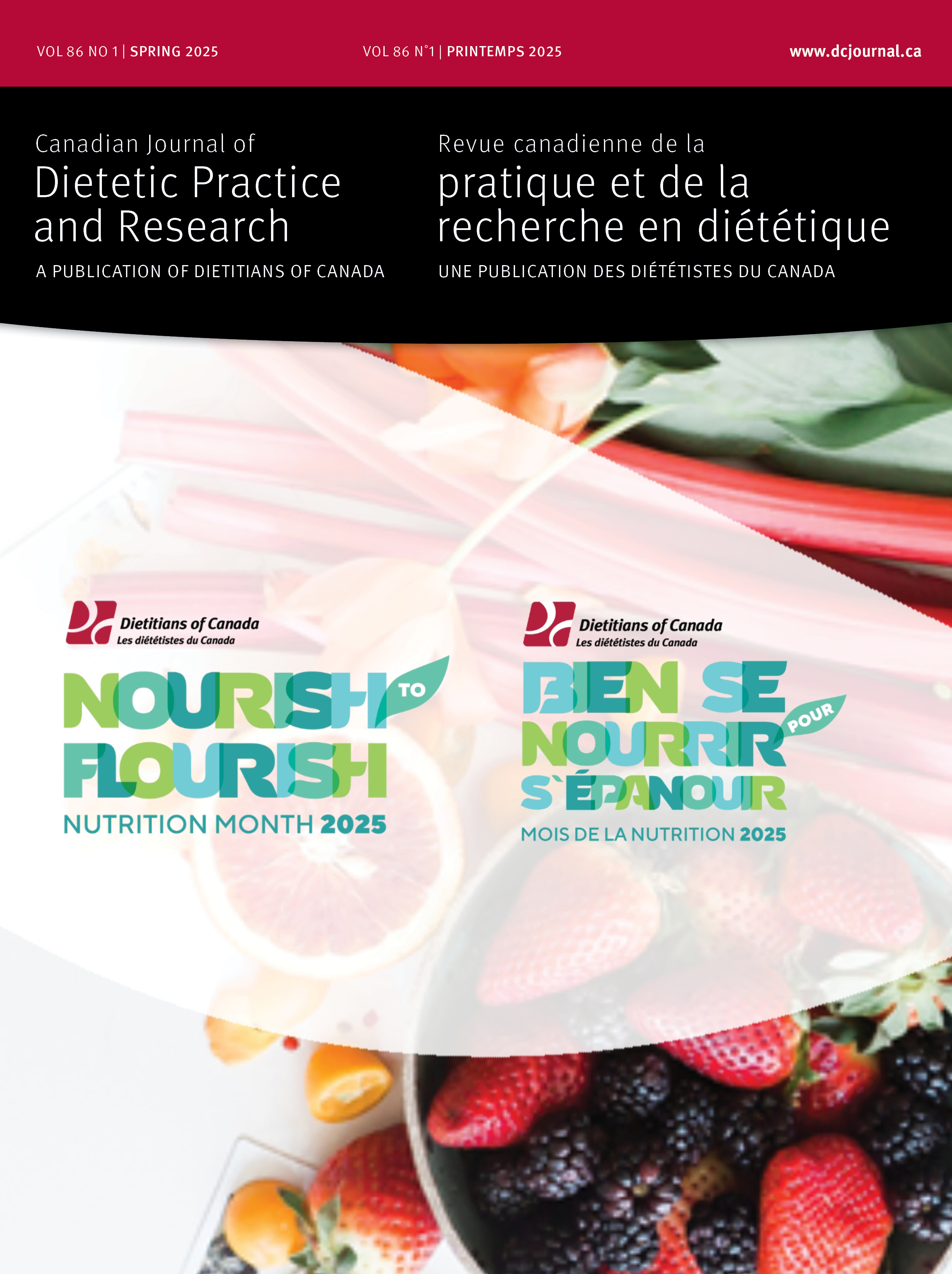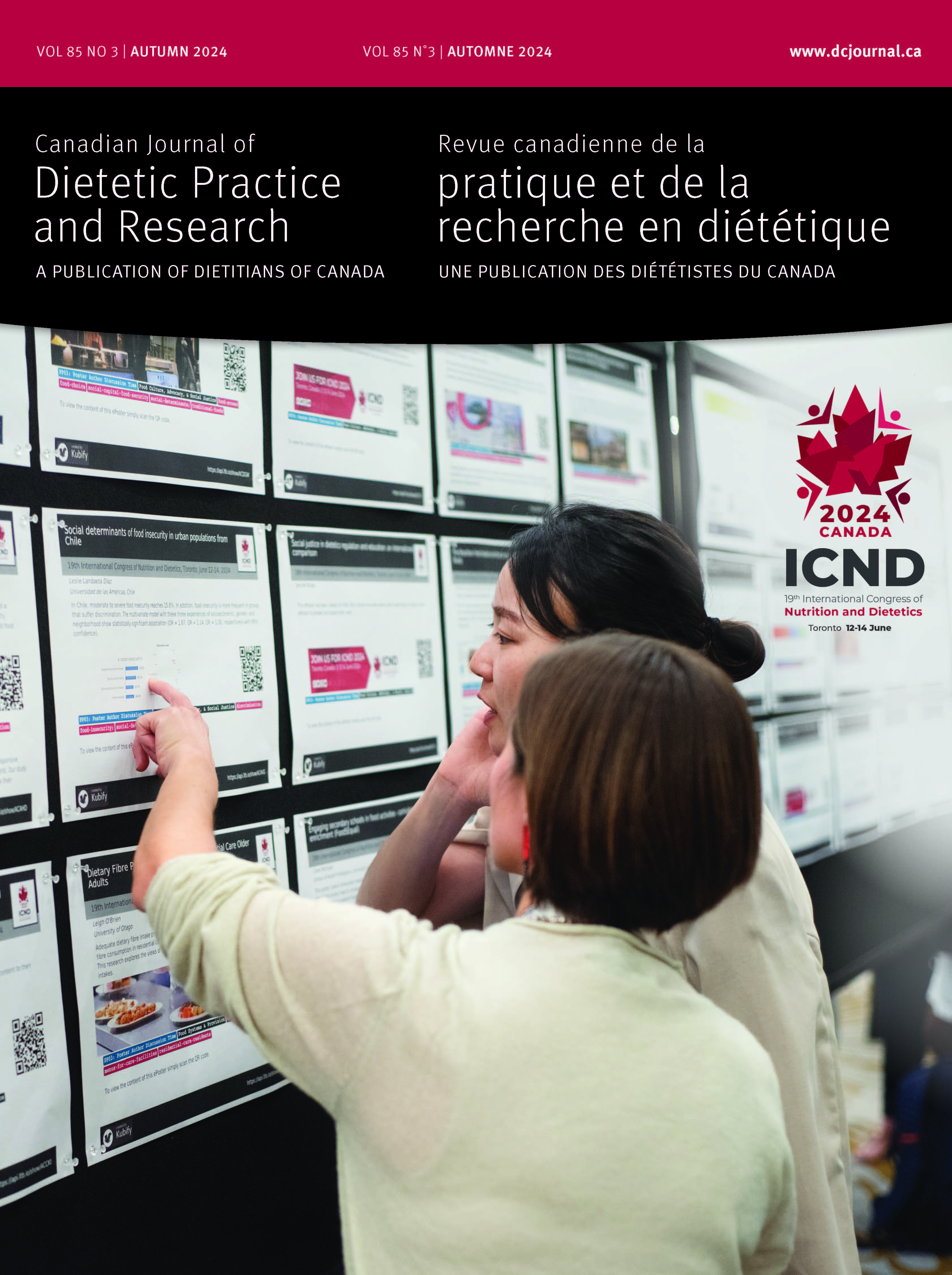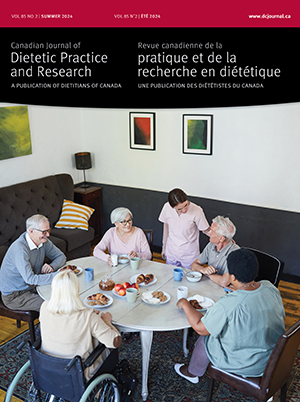Volume 65 • Number 4 • December 2004
Chair’s Message
Research
Healthy eating and active living have become key concepts in health promotion, and, increasingly, the two messages are being combined. Dietitians are in an ideal position to promote physical activity as an adjunct to nutrition counselling. Focus group interviews were used to identify dietitians’ perceptions and needs related to incorporating active living messages into their practices. Six focus groups, involving 42 participants (40 registered dietitians and two dietetic interns), were conducted in cities throughout Alberta. Issues explored during the interviews included the dietitian's role in promoting active living, barriers to promoting physical activity, opportunities for collaboration between dietitians and exercise professionals, and dietitians’ perceived needs for integrating active living messages into their practices effectively. Findings indicate strong support for incorporating active living messages into nutrition counselling. However, lack of knowledge was identified as a barrier to dietitians’ proactive role, and concerns were raised about public and professional perceptions if dietitians counselled on this issue. Participants felt that they required additional knowledge and training in physical activity in order to promote it effectively. Development and implementation of programs designed to meet these needs would help dietitians integrate active living messages into their practices.
Oxidative stress is one of the major contributors to increased risk of chronic diseases. A diet rich in tomatoes and tomato products containing lycopene, a carotenoid antioxidant, has been found to protect against these chronic diseases by mitigating oxidative damage. The study aim was to evaluate the effects of a long-term tomato-rich diet, consisting of various processed tomato products, on bioavailability and antioxidant properties of lycopene. Seventeen healthy human subjects (ten men, seven non-pregnant women) participated in the study. Following a two-week washout period during which subjects avoided foods containing lycopene, all subjects consumed test tomato products including tomato juice, tomato sauce, tomato paste, ketchup, spaghetti sauce, and ready-to-serve tomato soup providing 30 mg of lycopene a day for four weeks. At the end of treatment, serum lycopene level increased significantly (p <0.05), from 181.79 ± 31.25 to 684.7 ± 113.91 nmol/L. Similarly, total antioxidant potential increased significantly (p <0.05), from 2.26 ± 0.015 to 2.38 ± 0.17 mmol/L Trolox equivalent. Lipid and protein oxidation was reduced significantly (p <0.05). The results suggest that a tomato-rich diet containing different sources of lycopene can increase serum lycopene levels and reduce oxidative stress effectively.
Successful dietetic program graduates must have an entrepreneurial mindset and skills to respond to environmental changes and consumer trends. The purpose of this study was to determine current or intended entrepreneurship by graduates of a Dietitians of Canada accredited university program, as influenced by self-efficacy stemming from entrepreneurial experiences in education or early career, as well as by internal and external factors. This study employed an exploratory descriptive methodology with a questionnaire mailed to a discrete sample. Ninety graduates completed and returned the questionnaire for a response rate of 55%. Data analysis included descriptive statistics, two-way table analysis, the chi-square test for independence, and Fisher's exact test. Significant relationships were found between self-efficacy scores and entrepreneurial action, specific entrepreneurial experiences and entrepreneurial intent and action, dietetic internship and intent, and belief in the importance of business skills and intent. Those with entrepreneurial intent and/or action identified creativity, dietetic education/internship, persistence, business skills, and family/friend support as helping factors. These results suggest that undergraduate, internship, and continuing education programs for dietitians should incorporate activities that develop entrepreneurial skills and contribute toward an entrepreneurial mindset.
As a number of seasonal factors affect cutaneous synthesis of vitamin D, especially in young children, our objective was to verify if winter and summer vitamin D intakes in Quebec preschoolers reach the adequate intake of 5 µg/day. A three-month retrospective food frequency questionnaire and a 24-hour food recall were used with parents of 98 children (mean age 56 months) in summer and of 72 of these children (mean age 65 months) in winter. To ensure completeness of data, vitamin D content of foods not covered in the Canadian Nutrient File was taken from other sources. According to the food frequency questionnaire, total vitamin D intakes were 9.7 ± 4.3 g/day in summer and 11.6 ± 4.8 g/day in winter. Only 10% of children in summer and 7% in winter had an intake below 5 µg/day. The 24-hour food recall vitamin D intake estimate was lower (summer 7.0 ± 3.8 µg/day, winter 7.2 ± 4.2 µg/day). This difference could be partly due to a discrepancy in the estimation of multivitamin supplement intake. However, according to both estimates, vitamin D intakes appeared generally adequate in this sample of Quebec preschoolers.
Report
The prevalence of anemia in Aboriginal children is high, but, given the high burden of infection in these children, the extent to which anemia is due to iron deficiency and/or infection is unclear. To determine the contribution of iron deficiency to anemia, we screened 144 Aboriginal infants (70 boys, 74 girls) who were free from infection. The prevalence of anemia (hemoglobin <105 g/L) was 18.8%; caregivers reported that 53.5% of infants had had an infection in the two weeks before screening. Anemic infants were more likely than non-anemic infants to have had an infection before screening (74.1% versus 48.7%, p = 0.02), and anemic infants had a higher prevalence of iron deficiency revealed by low serum iron concentrations (< μ7 mol/L) (73.7% versus 38.3%, p <0.01). Iron deficiency measured using serum ferritin concentration tended to be less marked in infants who had had an infection (13% versus 30.3%, p = 0.06); this is probably because serum ferritin is a positive acute-phase protein. This study indicates the difficulty of isolating the contribution of infection to anemia from the separate effects of dietary iron deficiency.
To respond to a need to develop a national fee guideline, the Consulting Dietitians Network conducted a membership fee survey. A questionnaire requesting fee information for various nutrition consulting services was distributed to members as an insert with the Consulting Dietitians Network quarterly newsletter and by electronic mail. The response rate was 38.4% (98 respondents) and most respondents (74.5%) had urban practices. The most frequently charged fees (mode) for individual counselling ($75/hour), industry and commercial firm consultations ($150/hour), group facilitation ($150/hour), and media consultations ($150/ article) were highest in the region of Ontario, Quebec, and the Atlantic provinces. The most frequently charged fees (mode) for home visits ($100/hour), writing for newspapers ($250/hour), and menu reviews ($60/hour) were highest in the region of Saskatchewan and Manitoba. The minimum and maximum fees were significantly different for the three regions (Ontario, Quebec, and the Atlantic provinces; Manitoba and Saskatchewan; and Alberta, British Columbia, and Yukon Territory) studied for initial client consultations, industry and commercial firm consultations, and menu reviews (p<0.05). For home visits, teaching in an institution, seminar presentations, group facilitation, media consultations, and writing media articles, the differences in the minimum and maximum fees charged were highly significant (p<0.001). Entrepreneurial dietitians may use these data as a reference to establish and negotiate consultation fees.










